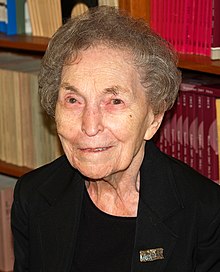Anna Schwartz | |
|---|---|
 Schwartz in 2007 | |
| Born | Anna Jacobson November 11, 1915 New York City, New York, U.S. |
| Died | June 21, 2012 (aged 96) Manhattan, New York City, New York, U.S. |
| Spouse(s) | Isaac Schwartz (1936–1999; his death) 4 children |
| Academic career | |
| Field | Monetary economics |
| Institution | National Bureau of Economic Research |
| School or tradition | Chicago school of economics |
| Alma mater | Barnard College Columbia University |
| Influences | Milton Friedman |
| Contributions | Analysis of money Analysis of banking |
| Information at IDEAS / RePEc | |
Anna Jacobson Schwartz (pronounced /ʃwɔːrts/ SHWORTS; November 11, 1915 – June 21, 2012) was an American economist who worked at the National Bureau of Economic Research in New York City and a writer for The New York Times. Paul Krugman has said that Schwartz is "one of the world's greatest monetary scholars."[1]
Schwartz collaborated with Nobel laureate Milton Friedman on A Monetary History of the United States, 1867–1960, which was published in 1963.[2][3] This book placed the blame for the Great Depression at the door of the Federal Reserve System.[4] Robert J. Shiller describes the book as the "most influential account" of the Great Depression.[5] She was also president of the Western Economic Association International in 1988.[6]
Schwartz was inducted into the National Women's Hall of Fame in 2013.[7]
- ^ Paul Krugman (March 29, 2007). "Who Was Milton Friedman?". The New York Review of Books. [verification needed]
- ^ "Milton Friedman". Policonomics. 2012. [verification needed]
- ^ Friedman, Milton (1989). "Collaboration in Economics". In Bordo, Michael D. (ed.). Money, History, and International Finance: Essays in Honor of Anna J. Schwartz. Chicago and London: The University of Chicago Press. pp. 246-249. ISBN 9780226065939.
- ^ Milton Friedman; Anna Jacobson Schwartz; National Bureau of Economic Research (2008). "B. Bernanke's speech to M. Friedman". The Great Contraction, 1929–1933. Princeton University Press. p. 247. ISBN 978-0-691-13794-0.
- ^ Shiller, Robert J. (2017). "Narrative Economics". American Economic Review. 107 (4): 967–1004. doi:10.1257/aer.107.4.967. ISSN 0002-8282.
- ^ "Past Presidents" (PDF). Western Economic Association International. Retrieved June 21, 2012. [verification needed]
- ^ National Women's Hall of Fame, Anna Jacobson Schwartz